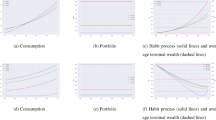Abstract
In this paper, we introduce a simple interactive agent mechanism, where the distribution of returns generated from the mechanism match stylized facts in financial markets. We introduce one more key factor, the length of time horizon on performance evaluations between strategies, which also has a significant influence on price fluctuations. To investigate the transitions among states, we introduce a Markov transition matrix, Perron‐Frobenius transition matrix, and Inertia. Our simulation results show the stickiness of states switching from one to another, and the longer length of time horizon on performance evaluations would generate more complex dynamic price fluctuations. We link our simple heterogeneous agent mechanism with Markov trajectory entropy and provide a total score and probability density functions of representations under two states as applications for the mechanism.


















Similar content being viewed by others
Notes
Here we set \(\varepsilon _{{1,t}} \sim N\left( {0,1} \right)\) and \(\varepsilon _{{2,t}}\) varies with different distributions: \(N\left( {0,1} \right)\), \(t\left( {\upsilon = 5} \right)\),
\({\text{stable}}\left( {\alpha = 1.5,\beta = 0,\sigma = 1,\mu = 0} \right)\), GARCH normal with \(\alpha _{0} = 0,\alpha _{1} = 0.9,\beta _{1} = 0.05\), GARCH t.
with \(\upsilon = 5,\alpha _{0} = 0,\alpha _{1} = 0.9,\beta _{1} = 0.05\), GJR t with \(\upsilon = 5,\alpha _{0} = 0,\alpha _{1} = 0.9,\beta _{1} = 0.05,\gamma = 0.1\),
FIGARCH (1,d,1) normal with \(\omega = 0.05,\alpha = 0.05,d = 0.4,\beta = 0.45\) and FIGARCH (1,d,1) t.
with \(\upsilon = 5,\omega = 0.05,\alpha = 0.05,d = 0.4,\beta = 0.45\).
Here 0.1 is the threshold \(\vartheta\) to induce fundamentalists having reaction responding to the popularity of their strategy.
References
Brock WA, Hommes CH (1997) A rational route to randomness. Econometrica 65(5):1059–1095
Cheng P-K, Kim YS (2017) Speculative bubbles and crashes: fundamentalists and positive-feedback trading. Cogent Econo Finance 5(1):1381370
Ekroot L, Cover TM (1993) The entropy of markov trajectories. IEEE Trans Inf Theory 39(4):1418–1421
Farmer JD (2002) Market force, ecology and evolution. Indus Corp Change 11(5):895–953
Farmer JD, Joshi S (2002) The price dynamics of common trading strategies. J Econ Behav Organ 49(2):149–171
Greenwood R, Nagel S (2009) Inexperienced investors and bubbles. J Financ Econ 93(2):239–258
Kirman A (1993) Ants, rationality, and recruitment. Q J Econ 108(1):137–156
Lux T (1995) Herd behaviour, bubbles and crashes. Econ J 105(431):881–896
Lux T (1997) Time variation of second moments from a noise trader/infection model. J Econ Dyn Control 22(1):1–38
Lux T (1998) The socio-economic dynamics of speculative markets: interacting agents, chaos, and the fat tails of return distributions. J Econ Behav Organ 33(2):143–165
Lux T, Marchesi M (1999) Scaling and criticality in a stochastic multi-agent model of a financial market. Nature 397(6719):498–500
Lux T, Marchesi M (2000) Volatility clustering in financial markets: a microsimulation of interacting agents. Int J Theor Appl Finance 3(4):675–702
Author information
Authors and Affiliations
Corresponding author
Additional information
Publisher's Note
Springer Nature remains neutral with regard to jurisdictional claims in published maps and institutional affiliations.
Rights and permissions
About this article
Cite this article
Cheng, PK. Transitions among states behind interactive agent model. Comput Math Organ Theory 28, 27–51 (2022). https://doi.org/10.1007/s10588-021-09337-w
Accepted:
Published:
Issue Date:
DOI: https://doi.org/10.1007/s10588-021-09337-w




